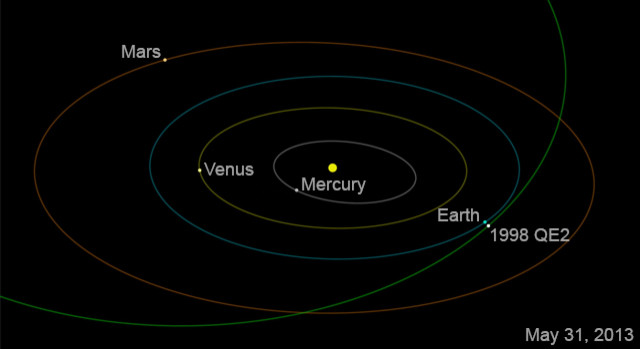Asteroid Flyby On May 31: Golden Gate Bridge-Sized Space Rock 1998 QE2 Will Swing Near Earth

An asteroid as long across as the Golden Gate Bridge will be making a relatively near pass by Earth on May 31 – thankfully, staying far away enough not to be worrisome.
The asteroid, dubbed 1998 QE2, will pass by on May 31 at 4:59 p.m. EDT, but will be out at a comfortable distance of 3.6 million miles – about 15 times the distance between the Earth and the moon, according to NASA's Jet Propulsion Laboratory.
The object called 1998 QE2 is about 1.7 miles across, which is as long as San Francisco’s famous bridge, or nine times the length of the Queen Elizabeth 2 cruise ship. It was discovered in August 1998 by the Massachusetts Institute of Technology’s Lincoln Near Earth Asteroid Research program. This pass will be the closest the asteroid gets for at least another 200 years, and scientists are gearing up to take high-resolution images as it flies by.
"Whenever an asteroid approaches this closely, it provides an important scientific opportunity to study it in detail to understand its size, shape, rotation, surface features, and what they can tell us about its origin,” JPL scientist Lance Benner said in a statement. “We will also use new radar measurements of the asteroid's distance and velocity to improve our calculation of its orbit and compute its motion farther into the future than we could otherwise."
You won’t be able to catch a glimpse of the asteroid through your home telescope, so for pictures, you’ll have to wait for radar images from the Goldstone and Arecibo observatories, which will be snapping shots of 1998 QE2 from May 30 to June 9. The asteroid’s shape is still a mystery. It could be shaped like anything -- space rocks aren’t uniformly round, and NASA has found asteroids shaped like everything from bowling pins to muffins, according to JPL.
It’s been an eventful year thus far for asteroid-watchers. An object named 2012 DA14, which was about half as long as a football field, swung by in February and came within 17,200 miles of Earth. Coincidentally, on the day of 2012 DA14’s closest approach, a schoolbus-sized meteorite exploded in the skies over Russia, injuring more than a thousand people. NASA scientists said the two events weren’t related.
Another asteroid that passed close to Earth this year was Apophis, which came within 9 million miles of us in January. When Apophis was discovered in 2004, scientists calculated there was a slim (2.7 percent) chance that it would strike Earth. Further calculations ruled this out, but left the possibility open for another collision in 2036.
But the most recent observations of Apophis, which is as wide across as about three-and-a-half football fields, show that the probability of an impact in 2036 is less than one in a million – close to impossible.
NASA is interested in observing asteroids up close, but without the threat of planetary annihilation. To that end, the space agency recently sought $100 million in federal funds for a mission to capture a relatively small asteroid in space and put it in orbit around the moon, the better to be observed.
© Copyright IBTimes 2024. All rights reserved.





















